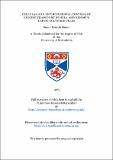Files in this item
Cellular and environmental control of glycine transport in HeLa and Xenopus laevis cultured cells
Item metadata
| dc.contributor.advisor | Lamb, J. F. | |
| dc.contributor.author | Hume, Susan Patricia | |
| dc.coverage.spatial | 97 p. | en_US |
| dc.date.accessioned | 2018-06-18T09:10:25Z | |
| dc.date.available | 2018-06-18T09:10:25Z | |
| dc.date.issued | 1975 | |
| dc.identifier.uri | https://hdl.handle.net/10023/14152 | |
| dc.description.abstract | 1 (a) Accumulative transport systems for glycine were identified in HeLa and Xenopus laevis kidney cells. In both cell types, influx and efflux obey Michaelis- Menten kinetics and kinetic constants were calculated for both parameters. A technique of 'lysing' and refilling cells facilitated the measurement of efflux from intracellular concentrations of amino acid which were sufficiently high to cause carrier saturation. In agreement with most previous work, glycine is not involved in a system of exchange diffusion. The cells' ability to accumulate glycine is considered to be due primarily to the differences in apparent Km values for entry and exit. (b) Replacement of extracellular Na ions with K, Li, or choline ions causes an increase in the apparent Km for influx and, in the absence of extracellular Na+, cells are unable to accumulate glycine against its concentration gradient. Analysis of the Na+-dependency of influx suggests that the rate-limiting step in influx involves the binding of a single Na ion per glycine molecule. 2 The cells' ability to transport glycine was modified by varying their growth conditions. If growth medium is replaced with fresh medium, glycine influx activity decays with a half-time of about 5 hours. The transport modification is associated with a reduction in Vmax and no change in the apparent Km of influx. This suggests that, although the structure of the carrier and its affinity for glycine remains unaltered, there is a reduction in either carrier mobility or the number of functionally active carriers. Regulatory control of a labile carrier could, therefore, be investigated, 3 Glycine transport was regulated by varying the serum concentration of growth medium. In both cell types, a progressive increase in the concentration of serum results in a proportional increase in influx and accumulation of glycine. The alteration in influx is again associated with variation in Vmax rather than altered carrier structure. It is not known whether this effect is linked with the growth-regulatory action of serum but it does provide evidence for the existence of serum factor(s) concerned either directly or indirectly with amino acid transport activity. Studies using cycloheximide support the existence of a labile carrier protein and indicate that protein synthesis is necessary for the serum-dependent increase in transport to occur. 4 A more rapid modification of transport was obtained by varying the concentration of substrate in the growth medium. An increase in the concentration of similarly transported amino acids during growth proportionally suppresses glycine influx, measured under fixed experimental conditions. The influx is minimal after growth in approximately normal growth-concentration of amino acid. Glycine influx is not influenced by the prior growth concentration of leucine. Both types of experiment indicated that pool size is not a major factor in the control mechanism. It is proposed that the limiting factor to control is the rate of membrane transport of substrate. | en_US |
| dc.language.iso | en | en_US |
| dc.publisher | University of St Andrews | |
| dc.subject.lcc | QP801.A5H8 | |
| dc.subject.lcsh | Amines | en |
| dc.title | Cellular and environmental control of glycine transport in HeLa and Xenopus laevis cultured cells | en_US |
| dc.type | Thesis | en_US |
| dc.type.qualificationlevel | Doctoral | en_US |
| dc.type.qualificationname | PhD Doctor of Philosophy | en_US |
| dc.publisher.institution | The University of St Andrews | en_US |
This item appears in the following Collection(s)
Items in the St Andrews Research Repository are protected by copyright, with all rights reserved, unless otherwise indicated.

